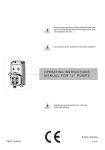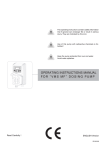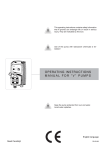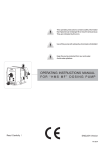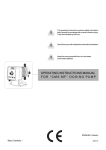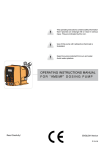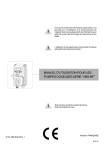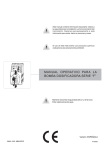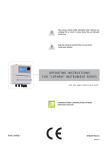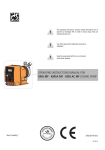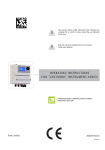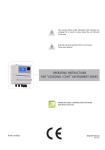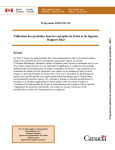Download OPERATING INSTRUCTIONS FOR “WDPHCL- ECL6” INS
Transcript
This manual contains safety information that if ignored can endanger life or result in serious injury. They are indicated by this icon. Keep the instrument protected from sun and water. Avoid water splashes. O P E R AT I N G I N S T R U C T I O N S F O R “ WD P H C L - E C L 6 ” I NS T R U M E N T Read Carefully ! ENGLISH Version 1 R1-09-08 “WDPHCL” instrument complies with the following European regulations: EN60335-1 : 1995, EN55014, EN50081-1/2, EN50082-1/2, EN6055-2, EN60555,3 Based on directive CEE 73/23 c 93/68 (DBT Low voltage directive) and directive 89/336/CEE (EMC Electromagnetic Compatibility) GENERAL SAFETY GUIDELINES Danger! In emergencies the instrument should be switched off immediately! Disconnect the power cable from the power supply! When installing always observe local regulations! Manufacturer is not liable for any unauthorized use or misuse of this product that may cause injury, damage to persons and / or materials. Caution! Instrument must be accessible at all times for both operating and servicing. Access must not be obstructed in any way! Feeder should be interlocked with a no-flow protection device to automatically shut-off the pumps when there is no flow! Pumps and accessories must be serviced and repaired by qualified and authorized personnel only! Always discharge the liquid end before servicing the instrument! Empty and rinse the liquid end before work on a pump which has been used with hazardous or unknown chemicals! Always read chemical safety datasheet! Always wear protective clothing when handling hazardous or unknown chemicals! Instrument must be operated / serviced by trained technicians only! All connection operations must be performed while the instrument is not connected to main supply! 2 1. Introduction WDPHCL is a fully Integrated All-in-One Swimming Pool Controller. Ideal for new construction projects the WDPHCL innovates panel mount capability into a small wall-mount package. 2 Pumps for Chlorine and pH adjustment in PVDF, small-form-factor saves space, installation time, and shipping expense. It includes Input for a Flow Switch. Integral pumps can handle up to 20 bar and 16 l/h (Self-Venting Liquid-end as option), high maintenance tubing sets and roller assemblies. Working ranges are: pH : from 0 to 14pH Chlorine: from 0 to 10 mg/l All information are provided through a large LCD display. Using a revolutionary wheel control the instrument can be easily programmed. WDPHCL is housed in a IP65 plastic box. 2. The wheel Located in the upper right side of WDPHCL there is a wheel that must be used to control the instrument. Wheel can be rotated in both directions to scroll over the menus and / or pressed to confirm highlighted selection / value. NOTE: Once changes are made press “OK” to save and exit from submenu. Press “ESC” to exit without saving. SCROLL Rotate wheel to scroll through menus or options SELECT Press wheel to select highlighted option 3 3. Mainboard Connections Unplug instrument from main power supply then perform connections to probes and / or selected outputs by following the above picture. LEFT PUMP HEAD (pH) RIGHT PUMP HEAD (Cl) (B) (H) (F) (G) (C) (E) (A) (D) (A) STAND-BY input (B) Flow input: 1 Blue (Ground) 31 24 2 Brown (+) 3 n/a 4 Black (Signal) (C) pH Level input (left pump head) (D) Cl Level input (right pump head) (E) pH EPHS probe connector (F) Cl ECL6 probe connector (G) Power Supply: 230VAC 50-60 Hz. (H) Alarm contact output: 1 n/a 31 24 2 Black 3 Red 4 n/a Warning: Connections must be perfomed by qualified and trained personnel only. 4 3.1 Hydraulic connections, hoses Unplug instrument from main power supply then perform connections to probes and / or selected outputs by following the above picture. Hydraulic connections are: Suction Hose with level probe and foot filter Delivery Hose with injection valve Discharge Hose Suction Hose. Completely unscrew tightening nut from pump’s head and remove assembling components: tightening nut, holding ring and pipe holder. Assembly as shown. Insert hose into pipe holder until it reaches the bottom. Lock hose on pump’s head by screwing down the tightening nut. Use only hands to do it! Connect other side of the hose to the foot filter using the same procedure. Delivery Hose. Completely unscrew tightening nut from pump’s head and remove assembling components: tightening nut, holding ring and pipe holder. Assembly as shown. Insert hose into pipe holder until it reaches the bottom. Lock hose on pump’s head by screwing down the tightening nut. Use only hands to do it! Connect other side of the hose to the injection valve using the same procedure. Discharge hose. Insert one side of discharge hose into pump head discharge connector. Insert other side of discharge hose into product’s tank. During priming procedure product exceeding will flow into tank. Suction Hose Tightening Nut Holding Ring Pipe Holder O-ring Valve 5 3.2 Hydraulic connections, level probes Assembling foot filter with level probe.Level probe must be assembled with foot filter using the provided kit. Foot valve is made to be installed into tank’s bottom without sediments priming problem. STEP 5 STEP 4 INSERT RING AS SHOWN STEP 3 INSERT PROBE WITH N.O. CONTACT UNTIL TO HEAR A CLICK STEP 2 INSERT FLOATER STEP 1 INSERT RING AS SHOWN Connect BNC from level probe into WDPHCL level inputs (“B” and “E” connectors). Put level probe assembled with foot filter into tank’s bottom. Warning: If there is a mixer installed into tank, install a suction lance instead of level probe / foot filter. 6 3.3 Hydraulic connections, pump heads Injection Valve. Injection valve must be installed on plant from water’s input. Injection valve will open at pressure greater than 0,3bar. To Delivery hose Discharge Knob Discharge hose (connector) To Suction hose 7 4. Main Screen When into normal operating mode, WDPHCL shows the following main screen: UNITS (1) VALUES (2) PUMPS STATUS (3) LEFT PUMP HEAD STATUS RIGHT PUMP HEAD STATUS Main screen is divided int 3 zones. (1) UNITS. “pH” is the measuring unit for pH probe. “mg/l” is the measuring unit for Chlorine probe. (2) VALUES These numbers are values read by the probes. (3) PUMPS STATUS These fields are related to current pumps status and instrument activity. DISPLAY WHAT TO DO IF OCCURS FEED ON Pump is dosing chemical product. No action required. FEED OFF Pump is OFF. No action required. LOW TANK Chemical product tank is almost empty. Check chemical tank. Restore correct level. NO FLOW External flow contact stops both the pumps. Check flow. Setpoint reached. No action required. FEED LIMIT Time for dosing exceeded. Dosing alarm. Check pump dosing capacity. PROBE FAIL Stuck reading values. Check probe for proper functioning. Pump activity delayed. Countdown in progress. If not requested check PARAMETERS options. pH priority dosage over Cl dosage. If not requested check PRIORITY options. OK DELAY WAIT PH 8 EXPLANATION 5. Quick status check From main screen rotate the wheel to review main instrument parameters and current status conditions. Current time Today date Current pH reading Current Chlorine reading Dosing alarm condition Probe failure status NO FLOW contact status Tank Level status Last pH calibration result Last pH calibration date Last Cl calibration result Last Cl calibration date 9 6. Password To grant access into “Main Menu” press the wheel from main screen and enter the passcode. If this is the first time here then the passcode is 0000 (factory preset). Press wheel 5 times to enter into “Main Menu”. Otherwise press the wheel 1 time and enter the passcode. Numbers can be selected rotating the wheel. X5 To set a new passcode choose “PARAMETERS” from “Main Menu” , move on “New Pcode”, click on wheel and enter a four numbers code. Click on “EXIT” and choose “YES” to save request. The new passcode is now ready. Lost passcode ? Please dont’ forget the passcode (if changed). In the unfortunate event, please call your local distributor for unlocking procedure. There is no way for you to recover lost passcode. 10 7. “Main Menu” list To grant access into “Main Menu” enter the passcode (as described in previous chapter). Once into “Main Menu” rotate the wheel to scroll through all the options available. Set-Point (see page 12) Calibration (see page 14) Parameters (see page 20) Pumps Activities (see page 21) Instrument Reset (see page 22) Max Strokes Settings (see page 22) Dosing Alarm (see page 23) International (see page 24) Probe Failure (see page 25) pH Compensation (see page 26) Disinfectant (see page 26) Flow (see page 27) Service (see page 27) Exit (to main screen) 11 8. “Set-Point”, pH (on/off) pH reading values can be set to operate the pH pump using 2 set-points into On/Off mode or Proportional (%). On/Off mode set the instrument to operate using two set values that enable or disable the pH pump. To use this mode move cursor on “Working Mode”. Press the wheel and select it. ON/OFF mode while dosing ALKALI Set pH value at 7.00 OFF and 6.90 ON. Instrument will leave the pH pump active until reading value will increase up to 7.00pH. At 7.00pH the pH pump will be disabled until reading value will decrease under 6.90pH. Waiting Time: to let pump operate at pulses per minutes add one or more minute (1pulse every xx minutes). Otherwise (00 minutes) pump will operate at set stroke settings (see page 22). ON OFF 6.90 12 7.00 8. “Set-Point”, pH (on/off) ON/OFF mode while dosing ACID Set pH value at 7.00 OFF and 7.10 ON. Instrument will leave the pH pump active until reading value will decrease up to 7.00pH At 7.00pH the pH pump will be disabled until reading value will increase up to 7.10pH. Waiting Time: to let pump operate at pulses per minutes add one or more minute (1pulse every xx minutes). Otherwise (00 minutes) pump will operate at set stroke settings (see page 22). ON OFF 7.00 7.10 To end procedure move cursor on “OK” and press wheel to proceed to “Save” request screen. Move wheel on “YES” to save or “NO” to discard changes. Do you know ? In chemistry, an alkali is a basic, ionic salt of an alkali metal or alkaline earth metal element. Alkalis are best known for being bases (compounds with pH greater than 7) that dissolve in water. The adjective alkaline is commonly used in English as a synonym for base, especially for soluble bases. This broad use of the term is likely to have come about because alkalis were the first bases known to obey the Arrhenius definition of a base and are still among the more common bases. Since Brønsted-Lowry acid-base theory, the term alkali in chemistry is normally restricted to those salts containing alkali and alkaline earth metal elements. An acid (often represented by the generic formula HA [H+A−]) is traditionally considered any chemical compound that, when dissolved in water, gives a solution with a hydrogen ion activity greater than in pure water, i.e. a pH less than 7.0. That approximates the modern definition of Johannes Nicolaus Brønsted and Martin Lowry, who independently defined an acid as a compound which donates a hydrogen ion (H+) to another compound (called a base). Common examples include acetic acid (in vinegar) and sulfuric acid (used in car batteries). Acid/base systems are different from redox reactions in that there is no change in oxidation state. 13 8.1 “Set-Point”, pH (proportional) pH reading values can be set to operate the pH pump using 2 set-points into On/Off mode or Proportional (%). Proportional mode set the instrument to operate using a calculated percentage between two set values that enable or disable the pH pump. To use this mode move cursor on “Working Mode”. Press the wheel and select it. PROPORTIONAL mode between 7pH(0%) and 8pH (100%). [Stroke setting 180] In this mode the pH pump will be “ON” for values greater than 8pH with maximum set strokes capacity (e.g.: 180) and it’ll be “OFF” for values lower than 7pH. For values of 7.5pH pump will be “ON” with 90 strokes capacity. The calculation is based on 180 strokes setting (see page 22). To end procedure move cursor on “OK” and press wheel to proceed to “Save” request screen. Move wheel on “YES” to save or “NO” to discard changes. 14 8.2 “Set-Point”, Cl (on/off) Cl reading values can be set to operate the Chlorine pump using 2 set-points into On/Off mode or Proportional (%). On/Off mode set the instrument to operate using two set values that enable or disable the Chlorine pump. To use this mode move cursor on “Working Mode”. Press the wheel and select it. ON/OFF mode Set Cl value at 0.80 mg/l ON and 1.00 mg/l OFF. The difference between the two Cl values is called HYSTERESIS. Instrument will enable the Chlorine pump when reading value will decrease at 0.80mg/l At 0.80mg/l the Chlorine pump will be enabled until reading value will increase at 1.00mg/l. Waiting Time: to let pump operate at pulses per minutes add one or more minute (1pulse every xx minutes). Otherwise (00 minutes) pump will operate at set stroke settings (see page 22). ON OFF 0.80 1.00 15 8.3 “Set-Point”, Cl (proportional) Cl reading values can be set to operate the pH pump using 2 set-points into On/Off mode or Proportional (%). Proportional mode set the instrument to operate using a calculated percentage between two set values that enable or disable the Chlorine pump. To use this mode move cursor on “Working Mode”. Press the wheel and select it. PROPORTIONAL mode between 1.00Cl (0%) and 0.50Cl(100%). [Stroke setting 180] In this mode the Cl pump will be “ON” for values lower than 0.50mg/l with maximum set strokes capacity (e.g.: 180) and it’ll be “OFF” for values greater than 1mg/l. For values of 0.75mg/l pump will be “ON” with 90 strokes capacity. The calculation is based on 180 strokes setting (see page 22). To end procedure move cursor on “OK” and press wheel to proceed to “Save” request screen. Move wheel on “YES” to save or “NO” to discard changes. To end procedure move cursor on “OK” and press wheel to proceed to “Save” request screen. Move wheel on “YES” to save or “NO” to discard changes. 16 9. “Probe Calibration”, pH pH calibration procedure involves two calibration points and it requires two buffer solutions. Default buffer solutions are pH 4.00 and pH 7.00. pH reading value can be also 30°C temperature compensated from “pH compensation” menu. From “Menu Calibration” choose “pH probe”. In the following example instrument will calibrate pH using default buffer solutions values. Note: this procedure assumes that instrument is correctly configured and a working pH probe connected. Otherwise unattended results may occurr. pH7 Calib 1st Point. Once into “pH Calibration” menu move wheel on “P1” then press wheel to enter into first point calibration submenu. Prepare 7.00pH buffer solution and dip probe’s sensor on it. Wait until reading value is stable and according to buffer solution value move wheel until it is the same on display (“Cal. at” field). Default value is 7.00pH. To end procedure move cursor on “OK” and press wheel to proceed to next step. Note: buffer solution value may change if environment temperature it’s different than 20°C. Read solution’s label for more information. According to this occurrence “pH Default” must be changed. Power Supply calibration ? To obtain the most reliable results during pulses calculation is possible to calibrate power supply read value. Press wheel on “P1” then move curso on “OK” and confirm power supply read value. (e.g.: 230V). 17 9. “Probe Calibration”, pH pH4 Calib 2nd Point. Move wheel on “P2” then press wheel to enter into second point calibration submenu. Prepare 4.00pH buffer solution and dip probe’s sensor on it. Wait until reading value is stable and according to buffer solution value move wheel until it is the same on display (“Cal. at” field). Default value is 4.00pH. To end procedure move cursor on “OK” and press wheel to proceed to “Save” request screen. Move wheel on “YES” to save or “NO” to discard changes. Note: buffer solution value may change if environment temperature it’s different than 20°C. Read solution’s label for more information. According to this occurrence “pH Default” must be changed. 18 9.1 “Probe Calibration”, Cl Cl calibration procedure involves probe’s selection, Zero (P1) and 2nd Point (P2) calibration. From “Menu Calibration” choose “Cl probe”. Note: This procedure assumes that instrument is correctly configured and a working Chlorine probe connected and installed on system. Measurement must be performed using plant water. Otherwise unattended results may occurr. Calib Zero (P1). Once into “Cl calibration” menu move on “P1” then press wheel to enter into calibration mode. For a correct system calibration proceed as follows. - install an “activated carbon filter” prior to probe’s holder. - let system water flow into probe holder for about 30 minutes. - press wheel (cursor must be on “Cal.at”). Remove filter. Carbon Filter System Calib 2nd point (P2). Now move on “P2” then press wheel to enter into calibration mode. For a correct system calibration use a Photometer or a DPD device to read chlorine on system. Enter value using the wheel then move cursor on “OK”. Now press the wheel. To end procedure move cursor on “OK” and press wheel to proceed to “Save” request screen. Move wheel on “YES” to save or “NO” to discard changes. If an error occurred during calibration procedure then the instrument will show an error message and will ask to proceed to a new calibration, cancel current operation or restore default settings. Photometer 19 10. “Parameters” From “Menu Calibration” choose “Parameters”. This menu allows to set a delay (max 60 minutes) before pumps begin to feed. Furthermore use this menu to set pH pump startup priority and to change default passcode. Feeding Delay. Move on “Feeding Delay” then press wheel. Choose a value between 0 (disabled) and 60 minutes (maximum delay time). This feature can be used to accord a startup delay for the pumps. Delay occurs when instrument is powered or after a “NO FLOW” contact recovery. Mode. Move on “Mode” then press wheel. If both pumps need to operate, a startup priority can be set to allow the pH pump to begin to feed prior to Cl pump. Choose “pH priority” to enable this function. Cl pump will begin to dose when pH pump has stopped. New Pcode. See page 10. To end procedure move cursor on “OK” and press wheel to proceed to “Save” request screen. Move wheel on “YES” to save or “NO” to discard changes. 20 11. “Pumps Activities” From “Menu Calibration” choose “Pumps activities”. This menu allows to manually operate one or both the pumps for a settable time. Move on “Mode” then press wheel. Choose “Man. Pump1” for manually operate pH pumps or “Man. Pump2” for Cl pump. Press wheel to move cursor on “TIME” field. Once here, choose a working time between 0 (disabled) or 199 minutes. Move on “EXIT”, then press wheel. Choose “YES” to save changes. Exit from main menu. Main display will show a countdown including the selected pump (left for pH pump, right for Cl pump). To stop this countdown go back to “Pump activities” menu and choose “ON” as working mode or wait until countdown ends. This function can be used for priming purposes. 21 11. “Instrument Reset” To restore instrument to its default values (including password) once into “Instrument Reset” menu, press wheel then change value to “ON”, press wheel again, move on “OK” then finally press wheel. The instrument display will show “CHECKSUM ERROR”. Press whell to return into “Main Menu”. Move on “EXIT”, then press wheel. The instrument is now restored to factory default. Please repeat all calibration procedures and programming parameters. 12. “Max strokes settings” pH and Cl pumps can be set to operate within a maximum number of strokes. Strokes are the total amount of injections per minute made by a pump. Using wheel choose a value for one or both pumps then move on “EXIT”. To end procedure move cursor on “OK” and press wheel to proceed to “Save” request screen. Move wheel on “YES” to save or “NO” to discard changes. Note: Pumps dosing capacity is based on 180 strokes per minutes 22 13. “Dosing Alarm” Use this menu to assign a maximum time to the pumps for reaching the setpoint. If set time ends and the pumps are still dosing, within this menu is possible to STOP them or just to show an alarm message. Function can be disabled selecting “OFF” instead of a number (minutes). Dosing alarm can be set for both or just one pump. E.g. To set Cl pump to stop after time ends and setpoint isn’t still reached press wheel, choose maximum time, press wheel move on next field and choose “STOP”. Time can be set between 0 and 100 minutes. When satisfied with settings move on exit and press wheel. To end procedure move cursor on “OK” and press wheel to proceed to “Save” request screen. Move wheel on “YES” to save or “NO” to discard changes. 23 14. “International” Use this menu to set international parameters as UNIT FORMAT (Europe IS or USA), Local Time and Date. Format. Use this option to use European or USA units format. See table for differencies. EUROPE IS (Internationl Standard) USA Date (DD/MMM/YY) Date (MMM/DD/YY) Time 24h Time AM / PM Time. Use this option to set local time. Date. Use this option to set date. Move on exit to end changes. To end procedure move cursor on “OK” and press wheel to proceed to “Save” request screen. Move wheel on “YES” to save or “NO” to discard changes. 24 15. “Probe Failure” Use this menu to assign a maximum time to connected probes to stay stuck. A stuck probe (it remains on same value for some time) means that probably probe itself is damaged. Within this menu is possible to STOP pumps or just to show an alarm message (probe failure) . Function can be disabled selecting “OFF” instead of a number (minutes). This function can be set for both or just one probe. E.g. To set Cl pump to stop after time ends and probe doesn’t change reading values press wheel, choose maximum time, press wheel move on next field and choose “STOP”. Time can be set between 0 and 100 minutes. When satisfied with settings move on exit and press wheel. To end procedure move cursor on “OK” and press wheel to proceed to “Save” request screen. Move wheel on “YES” to save or “NO” to discard changes. 25 16. “pH Compensation” To enable 30°C temperature compensation for pH probe press wheel then choose “ON”. For disabling temperature compensation choose “OFF”. To end procedure move cursor on “OK” and press wheel to proceed to “Save” request screen. Move wheel on “YES” to save or “NO” to discard changes. 17. “Disinfectant” To change disinfectant product type (chlorine based or bromine based) press wheel then move wheel to change “BROMINE” or “CHLORINE” then press wheel again. To end procedure move cursor on “OK” and press wheel to proceed to “Save” request screen. Move wheel on “YES” to save or “NO” to discard changes. Note: this changes affect main screen UNIT display [Br2 or Cl2]. 26 18. “Flow Contact” Flow contact (locate connection on page 4) can be enabled to stop all dosing activities using a N.O. contact (normally opened contact) or N.C. contact (normally closed contact). Move wheel for enabling and changing contact logic (N.O. or N.C). To end procedure move cursor on “OK” and press wheel to proceed to “Save” request screen. Move wheel on “YES” to save or “NO” to discard changes. 19. “Service” This “view only” menu shows probes reading live. Press “ESC” to exit. 27 20. Technical information. Power supply: 230 VAC (190÷265 VAC) pH range: 0 ÷14 ; Cl range: 0÷10 mg/l Pump Strokes: 0 ÷ 180 Suction Height: 1,5 metres Environment Temperature: -10 ÷ 45°C (14 ÷ 113°F) Chemical Temperature: 0 ÷ 50°C (32 ÷ 122°F) Installation Class: II Pollution Level: 2 Audible Noise (single head): 74dbA Packaging and Transporting Temperature: -10 ÷ 50°C (14 ÷ 122°F) Protection degree: IP 65 Product Formula Ceram. PVDF PP PVC SS 316 PMMA Hastel. PTFE FPM EPDM NBR PE Acetic Acid, Max 75% CH3COOH 2 1 1 1 1 3 1 1 3 1 3 1 Hydrochloric Acid, Concentrate HCl 1 1 1 1 3 1 1 1 1 3 3 1 Hydrofluoric Acid 40% H2F2 3 1 1 2 3 3 2 1 1 3 3 1 Phosphoric Acid, 50% H3PO4 1 1 1 1 2 1 1 1 1 1 3 1 Nitric Acid, 65% HNO3 1 1 2 3 2 3 1 1 1 3 3 2 Sulphuric Acid, 85% H2SO4 1 1 1 1 2 3 1 1 1 3 3 1 Sulphuric Acid, 98.5% H2SO4 1 1 3 3 3 3 1 1 1 3 3 3 Amines R-NH2 1 2 1 3 1 - 1 1 3 2 3 1 Sodium Bisulphite NaHSO3 1 1 1 1 2 1 1 1 1 1 1 1 Sodium Carbonate (Soda) Na2CO3 2 1 1 1 1 1 1 1 2 1 1 1 Ferric Chloride FeCl3 1 1 1 1 3 1 1 1 1 1 1 1 Calcium Hydroxide (Slaked Lime) Ca(OH)2 1 1 1 1 1 1 1 1 1 1 1 1 Sodium Hydroxide (Caustic Soda) NaOH 2 1 1 1 1 1 1 1 2 1 2 1 Calcium Hypochlor.(Chlor.ted Lime) Ca(OCl)2 1 1 1 1 3 1 1 1 1 1 3 1 Sodium Hypochlorite, 12.5% NaOCl + NaCl 1 1 2 1 3 1 1 1 1 1 2 2 Potassium Permanganate, 10% KMnO4 1 1 1 1 1 1 1 1 1 1 3 1 Hydrogen Peroxide, 30% (Perydrol) H2O2 1 1 1 1 1 3 1 1 1 2 3 1 Aluminium Sulphate Al2(SO4)3 1 1 1 1 1 1 1 1 1 1 1 1 Copper-II-Sulphate (Roman Vitriol) CuSO4 1 1 1 1 1 1 1 1 1 1 1 1 Resistance rating: (1: Resistant) ; (2: Fairly resistant) ; (3: Not resistant) Polyvinyldene fluoride (PVDF) Pump Heads, valves, fitting, tubing Polypropylene (PP) Pump Heads, valves, fitting, level floater PVC Pump Heads Stainless steel (SS 316) Pump Heads, valves Polymethyl Metacrilate (Acrylic) PMMA Pump Heads Hastelloy C-276 Injection valve spring Polytetrafluoroethylene (PTFE) Diaphragm Fluorocarbon (Viton® B) Sealings Ethylene propylene (EPDM) Sealings Nitrile (NBR) Sealings Polyethylene (PE) Tubing 28 21. Dimensions. mm [inches] Information on this manual may contain technical inaccuracies or typographical errors. The information contained may be changed at any time without prior notification or obligation. 29 22. Index 30 CE Conformity Declaration General Safety Guidelines page 2 page 2 Introduction The wheel page 3 page 3 Mainboard connections Hydraulic connections, hoses Hydraulic connections, level probes Hydraulic connections, pump heads Main screen Quick status check Password page 4 page 5 page 6 page 7 page 8 page 9 page 10 “Main menu” list “Set point” pH (ON/OFF) “Set point” pH (Proportional) “Set point”, Cl (ON/OFF) “Set point”, Cl (Proportional) “Probe Calibration”, pH “Power Supply Calibration” “Probe Calibration”, Cl “Parameters” “Pump Activities” “Instrument Reset” “Max Strokes settings” “Dosnig Alarm” “International” “Probe Failure” “pH Compensation” “Disinfectant” “Flow” “Service” page 11 page 12 page 14 page 15 page 16 page 17 page 17 page 19 page 20 page 21 page 22 page 22 page 23 page 24 page 25 page 26 page 26 page 27 page 27 Technical Information Dimensions Index page 28 page 29 page 30 31 When dismantling this instrument please separate material types and send them according to local recycling disposal requirements. We appreciate your efforts in supporting your local Recycle Environmental Program. Working together we’ll form an active union to assure the world’s invaluable resources are conserved. 32
































